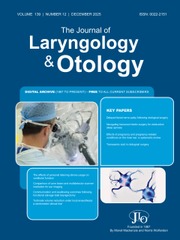No CrossRef data available.
Article contents
Outcomes in paediatric patients undergoing stapedotomy
Published online by Cambridge University Press: 21 October 2024
Abstract
This study aimed to describe outcomes of paediatric stapes surgery at an academic tertiary care centre.
Electronic medical records of patients younger than 21 years who underwent stapedotomy between September 2013 and July 2020 were reviewed.
A total of 17 patients (7 male, 10 female) were included in our study; 14 underwent surgery on one ear while 3 underwent surgery on both ears (20 ears total). Mean pre-operative air-bone gap was 34.5 dB (standard deviation, 11). At three months, the mean post-operative air-bone gap was 20.6 dB (standard deviation, 10.2), with a mean improvement of 17 dB (standard deviation, 12.1). Sixty-four per cent of patients had closure of their air-bone gap to 20 dB or less. A negative correlation between pre-operative body-mass index and post-operative air-bone gap was statistically significant (n = 14, p = 0.03, r = -0.57 [95% confidence interval -0.85, -0.04]).
Paediatric stapedotomy can be effective and safe. In this cohort, age was not correlated with improvement in air-bone gap; pre-operative body mass index was significantly correlated with post-operative air-bone gap.
- Type
- Main Article
- Information
- Copyright
- Copyright © The Author(s), 2024. Published by Cambridge University Press on behalf of J.L.O. (1984) LIMITED
Footnotes
Huseyin Isildak takes responsibility for the integrity of the content of the paper
Presented as a poster at the Combined Otolaryngology Spring Meetings (COSM), 3–7 May 2023, Boston, Massachusetts, USA.


